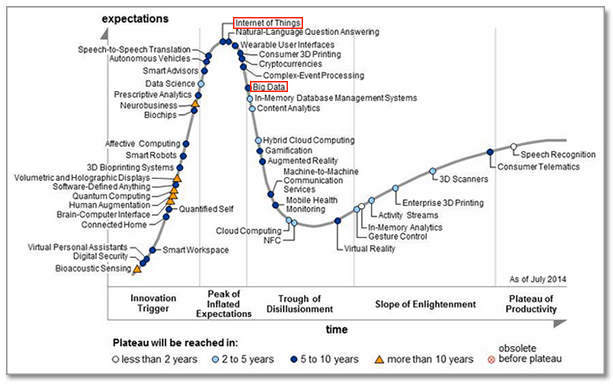I have to admit, I love the swell of Internet of Things devices and technology we’re seeing right now.
Smart alarm clocks that can wake you without waking your bedmate, smart showers that help you save water, a smart kettle or coffee pot you can start with your phone, a smart frying pan to alert you before you burn the eggs — and that’s all before breakfast.
Some IoT devices seem silly while others seem poised to help change the world. But the one thing they all have in common is that they aren’t really about the things themselves.
Source for picture: click here (2014 Gartner chart)
The Internet of Things is really all about data.
Big data is all about data, while the Internet of things involves data, devices, and connectivity, but in the end, they tend to come down to the same thing.
And while many companies are jumping on the IoT bandwagon — from big providers like Cisco and Dell all the way down to Kickstarter-funded startups — they’re all going to have to watch their data if they want to succeed.
I have three main suggestions for companies looking to benefit from the data their smart devices, sensors, and RFID tags gather:
- Ensure your data is accurate. As IoT devices reach consumers, the must become less expensive to produce and maintain. This could result in a loss of accuracy. For example, if you wear three different types of fitness monitors during a workout, you’re likely to get three different measurements of how many calories you’ve burned. At an individual level, the accuracy probably doesn’t matter that much — it won’t make a huge difference to me if I’ve burned 400 calories or 337 calories — but on a larger scale, it could make a huge difference, depending on what the company wants to learn from the data. Building a strategy on inaccurate data will not yield good results.
- Protect your data chain. Because people are only just beginning to think of data as a business resource, they are also only just beginning to think of protecting that resource. Any erroneous or altered data streams could affect the accuracy of the dataset on the whole. So far, security at the sensor level is the most difficult to achieve and maintain, but without a secure data chain, you can’t rely on accurate data.
- Collect the right data (and ask the right questions). As with all big data projects, data itself is useless without the right questions driving it. IoT data must have the right kinds of analysis projects behind it to make it useful for any business. You can know every movement of every shipment you ever send, but unless you can use that data to improve your processes, it is useless — expensive, and useless. IoT data collection has to be backed up by solid data analysis to be useful, and the business units need to be involved in dictating what data is collected and what analyses are performed.
So, while it is awfully cool to have a smart yoga mat to help you improve your poses, or a smart refrigerator so you don’t forget the milk, the IoT trend won’t go very far just for being clever or cool. But when the businesses behind those cool toys put the data they collect to work, they may find that the Internet of Things is real business.
How do you feel about the Internet of Things and smart devices? Cool or creepy? Business boom or bust? I’d love to hear your opinions in the comments below.
DSC Resources
- Career: Training | Books | Cheat Sheet | Apprenticeship | Certification | Salary Surveys | Jobs
- Knowledge: Research | Competitions | Webinars | Our Book | Members Only | Search DSC
- Buzz: Business News | Announcements | Events | RSS Feeds
- Misc: Top Links | Code Snippets | External Resources | Best Blogs | Subscribe | For Bloggers
Additional Reading
- The 10 Best Books to Read Now on IoT
- 50 Articles about Hadoop and Related Topics
- 10 Modern Statistical Concepts Discovered by Data Scientists
- Top data science keywords on DSC
- 4 easy steps to becoming a data scientist
- 13 New Trends in Big Data and Data Science
- 22 tips for better data science
- Data Science Compared to 16 Analytic Disciplines
- How to detect spurious correlations, and how to find the real ones
- 17 short tutorials all data scientists should read (and practice)
- 10 types of data scientists
- 66 job interview questions for data scientists
- High versus low-level data science
Follow us on Twitter: @DataScienceCtrl | @AnalyticBridge

